AMD Radeon HD 7990 Review: 7990 Gets Official
by Ryan Smith on April 24, 2013 12:01 AM EST- Posted in
- GPUs
- AMD
- Radeon
- Radeon HD 7000
- Tahiti
Compute
As always we'll start with our DirectCompute game example, Civilization V, which uses DirectCompute to decompress textures on the fly. Civ V includes a sub-benchmark that exclusively tests the speed of their texture decompression algorithm by repeatedly decompressing the textures required for one of the game’s leader scenes. While DirectCompute is used in many games, this is one of the only games with a benchmark that can isolate the use of DirectCompute and its resulting performance.
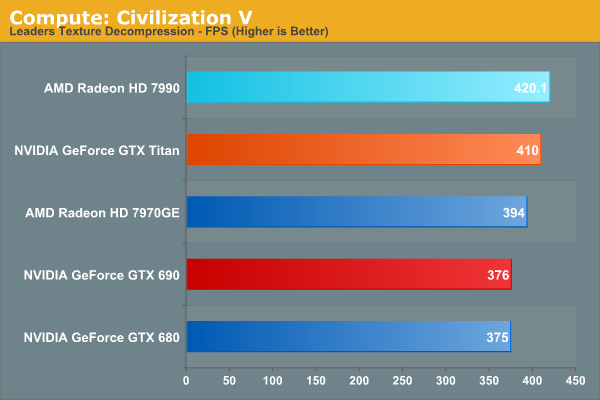
Civ V's texture compression routines are technically mutli-GPU capable, but multi-GPU scaling has never been particularly impressive here. So this test mostly reinforces what we already know about the Tahiti GPU being very capable in most DirectCompute workloads.
Our next benchmark is LuxMark2.0, the official benchmark of SmallLuxGPU 2.0. SmallLuxGPU is an OpenCL accelerated ray tracer that is part of the larger LuxRender suite. Ray tracing has become a stronghold for GPUs in recent years as ray tracing maps well to GPU pipelines, allowing artists to render scenes much more quickly than with CPUs alone.
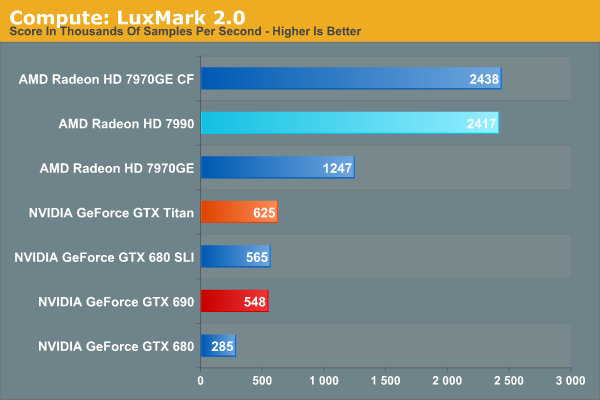
The 7990 isn’t billed as a compute product, but that doesn’t mean it’s at all weak at compute. On the contrary, as LuxMark doesn’t hit the ROPs hard the 7990 has no trouble staying under its 375W target, allowing it to sustain 1000MHz indefinitely. As a result the 7990 takes AMD’s compute advantage and runs with it. The 7990 is a bit more 2x the cost of a 680, but it’s 8.5x faster. Even against GTX Titan the difference is just short of 4x; NVIDIA simply doesn’t do well in our OpenCL tests.
Our 3rd benchmark set comes from CLBenchmark 1.1. CLBenchmark contains a number of subtests; we’re focusing on the most practical of them, the computer vision test and the fluid simulation test. The former being a useful proxy for computer imaging tasks where systems are required to parse images and identify features (e.g. humans), while fluid simulations are common in professional graphics work and games alike.
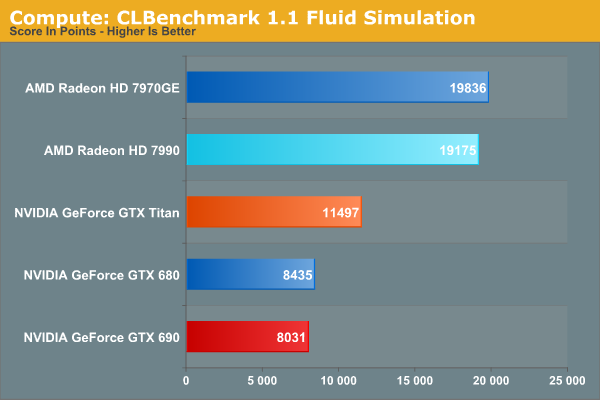
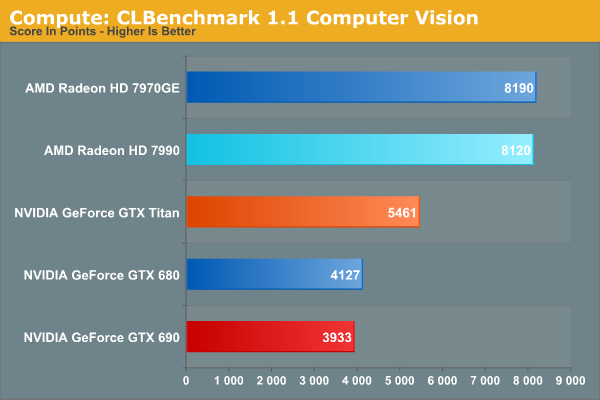
These two CLBenchmark sub-tests aren’t multi-GPU capable, so the performance of the 7990 is essentially dictated by its first GPU. All that means however is that the 7990 is once again at the top of the charts, well ahead of NVIIDA’s other cards and beating Titan by 50%-100%. At the same time this is a good reminder that not every compute task scales well across multiple GPUs, which is why single-GPU products still have a strong place in the GPU compute world.
Moving on, our 4th compute benchmark is FAHBench, the official Folding @ Home benchmark. Folding @ Home is the popular Stanford-backed research and distributed computing initiative that has work distributed to millions of volunteer computers over the internet, each of which is responsible for a tiny slice of a protein folding simulation. FAHBench can test both single precision and double precision floating point performance, with single precision being the most useful metric for most consumer cards due to their low double precision performance. Each precision has two modes, explicit and implicit, the difference being whether water atoms are included in the simulation, which adds quite a bit of work and overhead. This is another OpenCL test, as Folding @ Home is moving exclusively OpenCL this year with FAHCore 17.
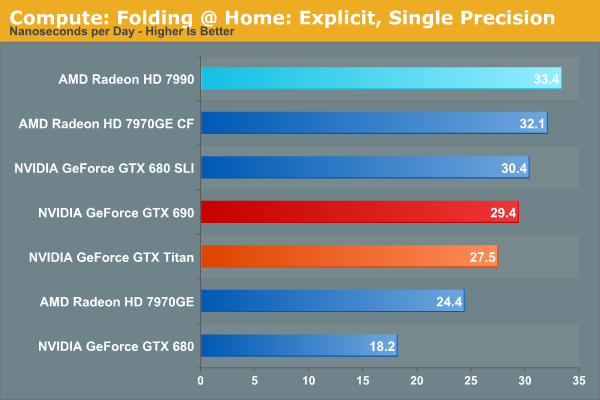
Only FAHBench’s explicit mode is multi-GPU capable, and even then the scaling to multiple GPUs isn’t great. Still, it’s enough to help the 7990 take the top spot on this benchmark, even with NVIDIA’s latest drivers slightly closing the gap. What’s particularly interesting here though is that the 7990 is faster than the 7970GE CF, and that’s not a fluke in our results. The 7990 should by all means be at least a bit slower, and more if throttling kicks in. It looks like we’re seeing one of those rare cases where the GPUs are benefitting from the presence of the PLX bridge, as going through the relatively close-by bridge is faster than in a two-card setup where the GPUs would have to communicate through the CPU/Northbridge. However this is the only time we see such an advantage; in most other compute scenarios – let alone gaming – the PLX bridge won’t have any kind of notable impact.
Wrapping things up, our final compute benchmark is an in-house project developed by our very own Dr. Ian Cutress. SystemCompute is our first C++ AMP benchmark, utilizing Microsoft’s simple C++ extensions to allow the easy use of GPU computing in C++ programs. SystemCompute in turn is a collection of benchmarks for several different fundamental compute algorithms, as described in this previous article, with the final score represented in points. DirectCompute is the compute backend for C++ AMP on Windows, so this forms our other DirectCompute test.
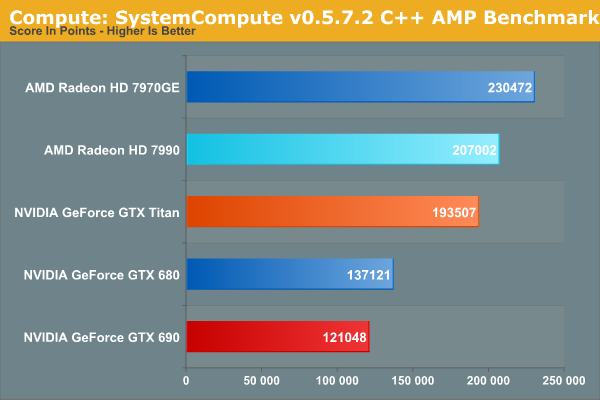
SystemCompute isn’t multi-GPU capable, so once again we’re leaning on the 7990’s first GPU. To that end we find the 7990 in second place, but we also see the 7790 clearly trailing the 7970GE by more than we’ve seen in our other compute benchmarks. SystemCompute does do a lot of I/O, so if FAHBench is the ideal case for showcasing the benefits of the PLX bridge in GPU to GPU I/O, then SystemCompute is good case for showcasing the drawbacks of the PLX bridge, mainly the higher I/O latency. It’s not enough to cripple the 7990 – it’s faster than the GTX Titan even here – but it does cost the 7990 some performance.










91 Comments
View All Comments
Ryan Smith - Wednesday, April 24, 2013 - link
One of our goals this year is to get a 4K monitor. But if so it will be a bit more mundane; something cheaper and more accessible, and something that can do 4K off of 1 DP 1.2 connection and present itself as one monitor.mayankleoboy1 - Wednesday, April 24, 2013 - link
How do you use SSAA in Crysis:Warhead ?Ryan Smith - Wednesday, April 24, 2013 - link
You can force it through the drivers on both AMD and NVIDIA cards.Veteranv2 - Wednesday, April 24, 2013 - link
One giant massive pro for the 7990 is compute performance. Nvidia clearly misses the ball there.StealthGhost - Wednesday, April 24, 2013 - link
Massive...for the 5% of people who buy cards like this and don't gameVeteranv2 - Wednesday, April 24, 2013 - link
Not all graphic cards are bought for gaming....And certainly in the future, compute for GPU will be more and more important.
Have you looked at the graphs? AMD has a GIANT leap over Nvidia.
Ktracho - Wednesday, April 24, 2013 - link
I think the compute benchmarking may be flawed. How many people who buy the Titan for compute will use OpenCL? I suspect almost all would be using CUDA. Since CUDA isn't available on AMD cards, I think a better benchmark would be HPL, which is a common benchmark in the HPC world. This would allow each manufacturer to show how much sustained performance a given card is capable of achieving, without being limited by the constraint of having to use OpenCL or DirectCompute, or whatever. Without such benchmark results, all that can be concluded without reservation is that if you must use OpenCL, then you really should limit yourself to AMD (at least for now).BrightCandle - Wednesday, April 24, 2013 - link
Lets be clear, you went live without FCAT results, which are singularly the most important aspect of reviewing this card as every other site has shown. Instead you chose to go with single FPS numbers, again.Pages upon pages of useless numbers, because the card doesn't actually display those frames. Using an older driver would have been better than using a prototype driver users aren't expecting to use for at least another month.
MartinT - Wednesday, April 24, 2013 - link
I agree, the data set in this review is of very limited import, especially for a CF-on-a-stick solution.You probably should have devoted more time to getting frame times into your workflow, and less time benchmarking so many games using less than relevant methodology.
Looking forward to your write up of the frame time data, but this article is a serious waste of time on your part, I'm afraid.
Ryan Smith - Wednesday, April 24, 2013 - link
Obviously we planned to have full FCAT data for this, but fate wasn't so agreeable. In any case FCAT is meant to augment our FPS data, not replace it. So we needed to have the FPS numbers before we could dig into FCAT for the full breakdown.And as a point of clarification, we aren't using the prototype driver for these results. We're using Catalyst 13.5b2, which should see a public release in the very near future. The prototype driver is another driver entirely, which we aren't using for these tests.